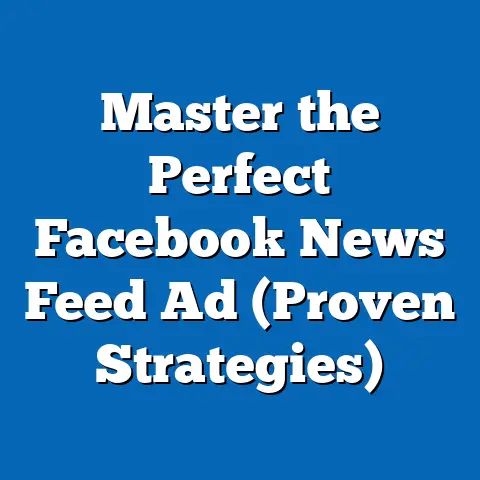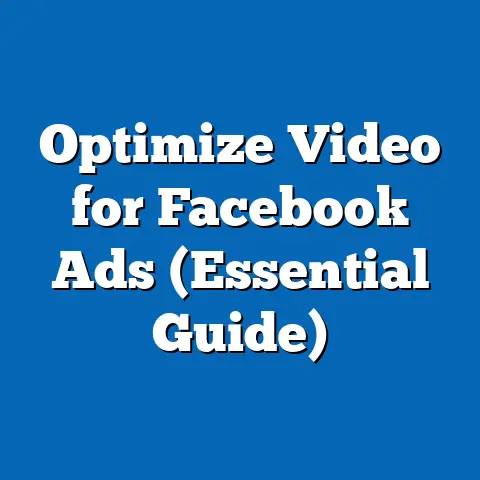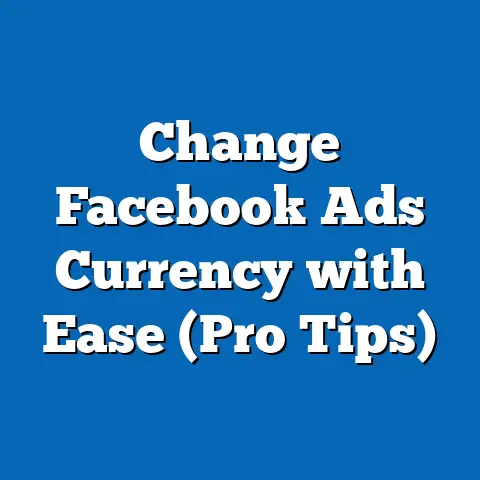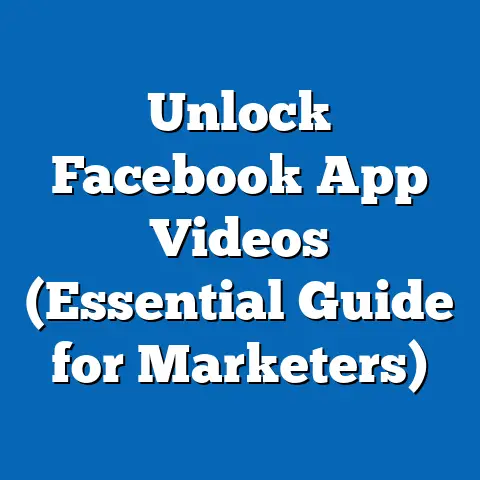Craft a Winning Facebook Ads Budget (Expert Tips Inside)
I remember talking to Sarah, the owner of a small boutique clothing store, a few years back. She was incredibly frustrated with her Facebook Ads. She’d poured money into campaigns, hoping to attract new customers, but the results were dismal. She felt like she was throwing money into a black hole, seeing little to no return. On the other hand, I’ve also seen businesses so afraid of spending money that they underfunded their campaigns, essentially whispering their message instead of shouting it. Both scenarios highlight a crucial point: a poorly planned Facebook Ads budget is a recipe for disaster.
Sarah’s story isn’t unique. Many businesses struggle with Facebook advertising, not because the platform doesn’t work, but because they haven’t mastered the art of budgeting. But after I sat down with Sarah, helped her analyze her data, refine her targeting, and restructure her budget, her business saw a remarkable turnaround. Her sales increased, her website traffic soared, and she finally understood the power of a well-crafted Facebook Ads budget.
This article is designed to guide you through the process of creating a winning Facebook Ads budget that aligns with your business goals and maximizes your ROI. Let’s dive in!
Understanding the Basics of Facebook Ads Budgeting
A Facebook Ads budget is simply the amount of money you’re willing to spend on your advertising campaigns. It’s the fuel that powers your ads, determining how many people see them and how often. Facebook offers two primary types of budgets:
- Daily Budget: This is the average amount you’ll spend each day on your ads. Facebook will try to stay within this budget, but it might occasionally spend slightly more or less depending on the opportunities available.
- Lifetime Budget: This is the total amount you’ll spend over the entire duration of your ad campaign. You also need to specify a start and end date for your campaign when using a lifetime budget.
Understanding key terms is crucial for effective budgeting:
- CPC (Cost Per Click): The amount you pay each time someone clicks on your ad.
- CPM (Cost Per Thousand Impressions): The amount you pay for every 1,000 times your ad is shown.
- ROI (Return on Investment): The profit you make from your ad campaigns compared to the amount you spent. This is the ultimate metric of success.
Facebook’s bidding system is a real-time auction where advertisers compete for ad space. Your budget and bid strategy play a significant role in determining whether your ads are shown and how much you pay. The higher your budget and the more competitive your bid, the more likely your ads are to be displayed to your target audience.
Assessing Your Goals and Objectives
Before you even think about numbers, it’s crucial to define what you want to achieve with your Facebook Ads. Are you looking to:
- Increase Brand Awareness?
- Generate Leads?
- Drive Sales?
- Increase Website Traffic?
- Promote an Event?
Your goals should be SMART: Specific, Measurable, Achievable, Relevant, and Time-bound. For example, instead of saying “I want to increase brand awareness,” you might say “I want to increase brand awareness among women aged 25-34 in the United States by 20% in the next three months.”
Different goals require different budget strategies. For example, if your goal is brand awareness, you might focus on CPM and reach as many people as possible. If your goal is lead generation, you might focus on CPC and target a smaller, more qualified audience. If your goal is sales conversions, you’ll likely need a larger budget to reach customers and track their purchases.
When I was working with a local bakery, their primary goal was to increase foot traffic to their physical store. We focused on a local awareness campaign with a daily budget of $20, targeting people within a 5-mile radius of the bakery. The campaign highlighted their daily specials and offered a small discount for first-time visitors. This targeted approach helped them attract new customers and boost their local presence.
Analyzing Your Target Audience
Understanding your target audience is paramount to maximizing your Facebook Ads budget. You can’t just throw money at a broad audience and hope for the best. You need to know:
- Demographics: Age, gender, location, education, income, etc.
- Interests: What are they passionate about? What pages do they like? What groups do they belong to?
- Behaviors: What do they do online? What are their purchasing habits? What devices do they use?
Facebook Insights and audience analytics tools provide valuable data about your existing customers and potential customers. You can use this data to create highly targeted audiences that are more likely to engage with your ads. This, in turn, will improve your ad relevance score and lower your costs.
For example, if you’re selling organic baby food, you might target new parents interested in natural living, healthy eating, and parenting blogs. By focusing on this specific audience, you’ll increase the chances of your ads being seen by people who are genuinely interested in your product.
I once helped a client who was selling high-end watches. Initially, they were targeting a broad audience interested in “luxury goods.” After analyzing their customer data, we discovered that their ideal customers were actually successful entrepreneurs and executives interested in specific watch brands, business magazines, and luxury travel. By refining their targeting, we were able to reduce their CPC by 40% and increase their conversion rate by 25%.
Determining Your Budget: Factors to Consider
Several factors influence how much you should spend on Facebook Ads. Here are some key considerations:
- Industry Benchmarks: Research average CPC and CPM rates in your industry. This will give you a starting point for your budget. Keep in mind that these are just averages, and your actual costs may vary.
- Competition: If you’re in a highly competitive industry, you’ll likely need a larger budget to stand out. Analyze your competitors’ ads and estimate their ad spend.
- Seasonal Trends: Advertising costs often fluctuate based on the time of year. For example, costs tend to be higher during the holiday season.
- Campaign Duration: A longer campaign will require a larger budget.
- Ad Placements: Different ad placements (e.g., Facebook News Feed, Instagram Feed, Audience Network) have different costs.
A/B testing is crucial for finding the right budget level. Start with a small budget and gradually increase it while monitoring your results. Test different ad creatives, targeting options, and bidding strategies to see what works best.
Budget allocation is also important. Don’t put all your eggs in one basket. Spread your budget across different campaigns, ad sets, and placements to diversify your risk and maximize your reach.
When I launched a campaign for a new mobile app, I started with a daily budget of $10 for each ad set. I tested different ad creatives and targeting options, gradually increasing the budget for the ad sets that were performing well and pausing the ones that weren’t. This iterative approach allowed me to optimize my budget and achieve a high ROI.
Monitoring and Adjusting Your Budget
Setting a budget is just the first step. You need to continuously monitor your ad performance and make adjustments as needed. Key metrics to track include:
- CTR (Click-Through Rate): The percentage of people who click on your ad after seeing it. A low CTR indicates that your ad creative or targeting isn’t resonating with your audience.
- Conversion Rate: The percentage of people who take the desired action (e.g., purchase, sign-up, download) after clicking on your ad. A low conversion rate indicates that your landing page or offer needs improvement.
- Cost Per Conversion: The amount you pay for each conversion. A high cost per conversion indicates that your budget is not being used efficiently.
- Reach: The number of unique users who saw your ad.
- Frequency: The average number of times each user saw your ad. A high frequency can lead to ad fatigue.
If you notice that an ad is underperforming, don’t be afraid to pause it and reallocate the budget to a more successful campaign. Experiment with different ad creatives, targeting options, and bidding strategies to see what works best.
Facebook Ads Manager provides detailed analytics that allow you to track your ad performance in real-time. Use this data to make informed decisions about your budget.
I had a client who was running a campaign to promote a webinar. Initially, their cost per registration was quite high. After analyzing their data, we discovered that their ads were performing well on mobile devices but poorly on desktop. We decided to reallocate their budget to mobile placements only, which significantly reduced their cost per registration.
Expert Tips for Maximizing Your Facebook Ads Budget
Here are some actionable tips from industry experts on optimizing your Facebook Ads budget:
- Retargeting Strategies: Retargeting allows you to show ads to people who have previously interacted with your website or Facebook page. This is a highly effective way to increase conversions. I would suggest you to use retargeting campaign to convert non-customers into customers.
- Leveraging Lookalike Audiences: Lookalike audiences allow you to reach new people who are similar to your existing customers. This is a great way to expand your reach and find new leads.
- Utilizing Facebook Pixel: The Facebook Pixel is a piece of code that you install on your website. It allows you to track conversions, optimize your ads, and build retargeting audiences.
- Ad Scheduling: Schedule your ads to run during the times when your target audience is most active.
- Ad Creative Optimization: Continuously test and optimize your ad creatives to improve your CTR and conversion rate.
- Stay Updated: Facebook’s advertising policies and features are constantly evolving. Stay updated with the latest trends and best practices to ensure compliance and effectiveness.
I’ve personally seen retargeting campaigns deliver incredible results. By showing ads to people who have visited a website but haven’t made a purchase, you can remind them of your product and encourage them to complete the transaction. This is a highly effective way to increase sales and improve your ROI.
Conclusion
Crafting a winning Facebook Ads budget is not a one-time task; it’s an ongoing process of planning, implementation, monitoring, and optimization. By understanding the basics of Facebook Ads budgeting, assessing your goals, analyzing your target audience, considering key factors, monitoring your performance, and implementing expert tips, you can maximize your ROI and achieve your advertising objectives.
I encourage you to implement the expert tips shared in this article and experiment with different strategies to find what works best for your business. Remember, the key to success is to be data-driven, adaptable, and persistent. With a strategic approach to budget planning, you can unlock the full potential of Facebook advertising and drive significant growth for your business. Now, go out there and create a Facebook Ads budget that works for you!





